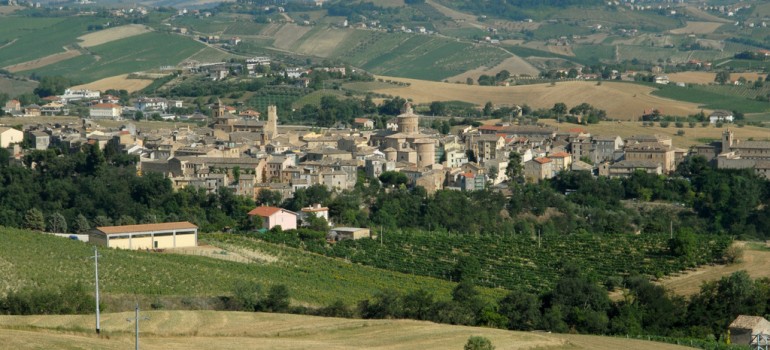
Offida, located 293 meters above sea level, is the capital of the wine production in the Piceno area and has a DOCG “Offida” characterized by three types of wines: Pecorino, Passerina, Offida Rosso, and a DOC wine called “Terre di Offida” (Passerina Raisin, Vin Santo and sparkling wine). Offida also boasts one of the most interesting and best preserved historic centers in the area. Archeological diggings, dating back to the 7th-6th centuries b.C., offer evidence of the town’s prehistoric origins. Its placename dates back to ancient times and is thought to derive either from the word OPHIS, which means “Snake” or from “Oppidum”, a fortified Roman locality or even from the Etruscan word Ophyte. The nucleus of the modern town may have risen from the Castel founded by the Longobard people, between the 6th and 9th centuries. Today Offida is renowned throughout the Piceno area both for its valuable artistic and monumental richness and for its economic activities, connected mainly agriculture. Among local craft, on of the most important products is “merletto a tombolo”, that is, handmade lace trimmings. At the town entrance one can see the massive structure of the Fortress (Rocca), built in 1487-1494 upon request of Pope Innocenzo VIII. In its spacious circular tower, the antique door and the fortified bastion of the castle are still intact. Its interior houses the Civil Hospital built by Pietro Maggi (1796) with its Neoclassic façade in brick. Next to the fortress we find the monuments dedicated to the lace workers, the Merlettaie (1893) and to the fallen in war, Caduti (1923). In the central square “Piazza del Popolo”, stands the Town Hall, an example of elegantly proportioned 1400s architecture. It boasts a panoramic high porch adorned by a refined loggia with graceful travertine columns. The porch leads to the “Serpente Aureo Theatre”, built by Pietro Maggi and inaugurated in 1823. The New Collegiate Church, adorned with both Rococò and Neoclassic elements, also looks upon the main square. The internal plan is derived from a Latin cross with three naves. Its is noteworthy for its unusual structure, boasting a drum cupola with four panache. Walking along Roma Street we arrive at the 1800s Palazzo Castellotti, which houses the Archeological Museum “G.Allevi”, the Civic Art Gallery (Piancoteca Comunale) and the Museum of Popular Traditions. Offida’s most fascinating monument, St. Maria della Rocca Church, stands dramatically on an isolated cliff. Constructed in brick (cotto), the church is a lovely, example of Romanesque-Gothic style. It was reconstructed in 1330, and has three slender polygonal apses, articulated with travertine spines and a Gothic portal at the base of the central apse. The crypt doorway, decorated with images of flowers and strange animals, leads directly to the principal apse. The crypt, whose columns and cross vaults cover the same extension of the upper church, contains frescos of the 14th century. Among the most important local popular folklore events, we must mention the Carnival of Offida, whose festivities begin on “Fat Friday” (Venerdì Grasso) when an enthusiastic group of young people dressed in guazzarò – a traditional rural costume – go chasing Lu Bove Fint: a fake ox carried on the shoulders of the merry-makers and playfully taunted throughout the town, followed by a festive crowd of supporters. The ox finds its symbolic slaughterhouse under the Civic Palace. During Carnival’s last day, members of the different quarters, clotherd in traditional costume make a procession around the town bringing the V’lurd (sheaves of burning reeds) to a huge bonfire. The atmosphere of masquerade, dancing and singing offers a final, playful goodbye to the fading Carnival.